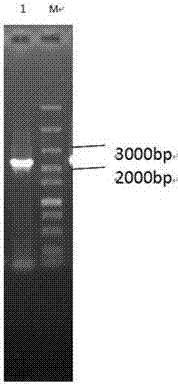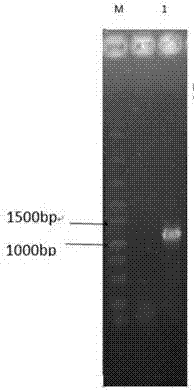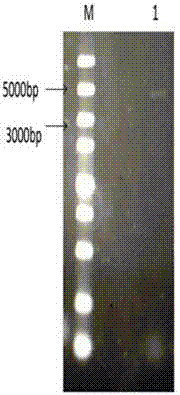Method of modifying phenol substances through CO2 biological conversion method and application of the method
A technology for biotransformation and phenolic substances, applied in the field of synthetic biology, can solve problems such as reduction of carboxyl groups, and achieve the effects of reducing carbon emissions, shortening synthesis steps, and reducing separation burden
- Summary
- Abstract
- Description
- Claims
- Application Information
AI Technical Summary
Problems solved by technology
Method used
Image
Examples
Embodiment 1
[0053] Carboxylase gene from Bacillus subtilis yclBCD (gene sequence 1), salicylate decarboxylase gene of yeast sdc (gene sequence 2) and the carboxylic acid reductase gene in Nocardia car (Gene sequence 3) clone
[0054] (1) Look up Carboxylate Reductase in GenBank car and phosphopantethein transferase sfp The gene sequence of Car was derived from Nocardia NRRL5646 and sfp from Bacillus subtilis , The sequence names are: AY495697.1 and WP_015715234.1, respectively. The carboxylic acid reductase and phosphopantetheinyl transferase genes were synthesized by a bio company and named as car– sfp, car – sfp The fragment of gene size is 4343bp (gene sequence is 3).
[0055] (2) Check yclBCD The gene sequence in GenBank is: 2632649, 2632650, 2632651 three-segment gene, which is derived from Bacillus subtilis 168 ( B. subtilis subsp. subtilis 168), obtained from the Bacillus subtilis 168 genome by PCR. Cloning of Bacillus subtilis 168 genome by PCR reaction yclBC...
Embodiment 2
[0064] Construction of Escherichia coli BL21(DE3) Engineering Bacteria Recombinantly Expressing Carboxylase and Carboxylate Reductase Genes
[0065] (1) Construction of expression vector
[0066] The cloned carboxylase gene yclBCD fragment and sdc Fragment, with restriction endonucleases Kpn I and Nde I respectively for the carboxylase gene yclBCD fragment and sdc The fragment was subjected to double enzyme digestion, and the 100 μL enzyme digestion system was as follows:
[0067] PCR carboxylase gene product 40 μL, 10×H buffer 10 μL, 10×BSA 10 μL, Kpn I 15 μL, Nde I 15 μL, ddH 2 O 10 μL. After digesting at 37°C for 4 hours, it was recovered by agarose gel electrophoresis.
[0068] The expression vector pETDuet-1 was double digested with restriction endonucleases Kpn I and Nde I, and the 100 μL digestion system was as follows: expression vector pETDuet-1 40 μL, 10×H buffer 10 μL, 10×BSA 10 μL, Kpn I 15 μL, Nde I 15 μL, ddH 2 O 10 μL. After digesting at 37°C for 4 ho...
Embodiment 3
[0077] CO 2 Preparation of p-Hydroxybenzyl Alcohol by Carboxylation and Reduction of Phenol by Biotransformation Method
[0078] (1) Take the recombinant pETDuet obtained in Example 2 of the overnight culture – yclBCD - car –sfp Inoculate genetically engineered bacteria into 50ml LB medium, at 37°C, 200r / min -1 When the absorbance OD600 of the bacterial solution reaches 0.6-0.8, add isopropylthiogalactoside (IPTG) to make the final concentration 0.1mM, at 37°C, 200r / min -1 Under culture for 4-4.5h. Then add 15mmol / L of phenol and 100mmol / L of sodium bicarbonate. After culturing for 12 hours, centrifuge and filter to obtain the fermentation broth.
[0079] The reaction formula is as follows:
[0080]
[0081] (2) HPLC analysis of fermentation products
[0082] Agilent liquid chromatography was used for detection, and the detection conditions were: Kromstar C 18 (250 mm×4. 6mm, 5 μm) chromatographic column, mobile phase methanol (A)-0.1% acetic acid aqueous solution ...
PUM
 Login to View More
Login to View More Abstract
Description
Claims
Application Information
 Login to View More
Login to View More - R&D
- Intellectual Property
- Life Sciences
- Materials
- Tech Scout
- Unparalleled Data Quality
- Higher Quality Content
- 60% Fewer Hallucinations
Browse by: Latest US Patents, China's latest patents, Technical Efficacy Thesaurus, Application Domain, Technology Topic, Popular Technical Reports.
© 2025 PatSnap. All rights reserved.Legal|Privacy policy|Modern Slavery Act Transparency Statement|Sitemap|About US| Contact US: help@patsnap.com



